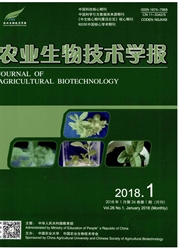

 中文摘要:
中文摘要:
Rop(Rho—related GTPase of plant)是植物中存在的一种特殊的小G蛋白。其与GTP(guanosine triphosphate)结合形成激活态,与GDP(guanosine diphosphate)结合形成失活态,并通过其激活态和失活态的转换启动和终止植物多种信号过程。Rop不同结合形式的转换受到一系列调控因子的调控。本研究以一个辣椒(CapsicumannuumL.)Rop蛋白(CaRopl)的组成型激活态CA—CaRopl为诱饵,利用ProQuestTM酵母双杂交体系,从辣椒幼苗猎物文库中分离获得一种RopGTPase激活蛋白(RopGTPaseactivatingproteins,RopGAD)基因,将其命名为CaRopGAP3。生物信息学分析表明,CaRopGAP3全长1597bp,包含一个1437bp的开放阅读框,编码478个氨基酸,其氨基酸序列不仅含有3个保守的GAP结构域,其N端还含有CRIB(Cdc42/Rac—interactive binding motif)结构域,属于植物特有的一类RopGAP亚家族。酵母双杂交验证显示CaRopGAP3只能与组成型激活态(CA)的CA.CaRopl互作而不能与显性失活态(DN)的DN—CaRop1互作,且含CRIB结构域的N端对他们之间的互作没有明显的调控作用。亚细胞定位分析显示,CaRopGAP3主要分布于细胞膜上,且含CRIB结构的N端在其膜定位中起重要调节作用。荧光定量PCR分析显示,CaRopGAP3基因在辣椒幼叶中的表达量最高,约为幼根的17倍、成熟根和花器官的8倍。CaRopGAP3基因的这种结构及组织表达特点可能与其参与的特定信号路径密切相关。本研究为进一步解析辣椒CaRopl介导的信号调控机制提供基础数据。
 英文摘要:
英文摘要:
Rop (Rho-related GTPase of plant)is the plant-specific signaling small GTPase. It can start and terminate multiple cell behavious by converting its active guanosine triphosphate (GTP)-bound form and inactive guanosine diphosphate (GDP)-bound form. The interconversion of the two forms of Rop GTPases in plant is strictly regulated by three types of regulators: GTPase activating proteins (RopGAPs), guanine nucleotide exchange factors (RopGEFs) and guanine nucleotide dissociation inhibitors (RopGDIs). In this study, with the bait of CA-CaRopl which is the GTP-bound form mutant of a Capsicum annuum L. Rop, CaRop 1, we screened a regulator of Rho GTPase activating protein, designated as CaRopGAP3, from the prey library of the pepper seedling by ProQuestTM two-hybrid system. Blastp analysis showed that the deduced amino acid sequence of CaRopGAP3 not only had conserved domains of GAP but also had the Cdc42/Rac-interactive binding (CRIB) domain, which indicated that the CaRopGAP3 was a CRIB-containing RopGAP subfamily that was unique to the regulation of the Rop GTPase of plant. Yeast two-hybrid analysis showed that CaRopGAP3 could interact with constitutively active (CA)-CaRopl but not with dominant negative (DN)-CaRopl, and the interaction was not obviously regulated by its CRIB-containing N-terminus. Subcellular localization analysis showed that the full-length CaRopGAP3 focused mainly on the cytomembmne while the truncated mutant that the CRIB-containing N-terminus was deleted dispersively distributed in the whole cytoplasm, which indicated that the CRIB-containing N-terminus may play important role in the membrane localization of CaRopGAP3. Real-time PCR analysis showed that the expression level of CaRopGAP3 in different tissues and organs were obvious different, the level in the young leaf was highest and was about 17-fold higher than that in the young root, 8-fold higher than that in the mature root and flower. The structure characterizations and the expression pattern of the
 同期刊论文项目
同期刊论文项目
 同项目期刊论文
同项目期刊论文
 CaWRKY58, encoding a group I WRKY transcription factor of Capsicum annuum, negatively regulates resi
CaWRKY58, encoding a group I WRKY transcription factor of Capsicum annuum, negatively regulates resi Overexpression of a Chinese cabbage BrERF11 transcription factor enhances disease resistance to Rals
Overexpression of a Chinese cabbage BrERF11 transcription factor enhances disease resistance to Rals Functional Analysis and Expressional Characterization of Rice Ankyrin Repeat-Containing Protein, OsP
Functional Analysis and Expressional Characterization of Rice Ankyrin Repeat-Containing Protein, OsP 期刊信息
期刊信息
